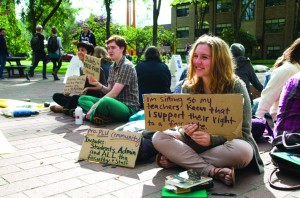
Last spring, Students of the Left spoke up about supporting contingent faculty’s right to join the Service Employees International Union.
On Wednesday, however, they chose a different tactic to express solidarity with the faculty members who would be able to vote.
Senior Julia Walsh said, “I don’t have a personal interest in whether the faculty decide to unionize. I have an interest in whether the faculty have a choice. They should have the choice.”

The contingent faculty debate has been brewing at least since spring 2011, when a survey revealed that a significant number of contingent faculty were dissatisfied with their wages and job security.
The issue came to a head when a significant portion of contingent faculty members filed union cards with SEIU, and some faculty declared their intention to join the union in an open letter to the PLU administration, which they published in The Mooring Mast as a paid advertisement.
The PLU administration immediately expressed opposition to the unionization effort.
Since then, students and faculty alike have been trying to make sense of the situation, with SEIU distributing pro-union information and campaigning hard to gain student and faculty support.
Meanwhile, the PLU administration has been releasing carefully crafted statements that some students and faculty said did not answer their questions.Many contingent faculty members have remained tight-lipped on their stance on unionization for fear of losing their jobs. This timeline attempts to accurately summarize the chain of events leading up to October’s election.
Spring 2011: The PLU chapter of the American Association of University Professors publishes a survey of contingent faculty members’ working conditions.
Fall: For the first time, the amount of financial aid provided by the university is greater than the amount spent on faculty compensation. Stephen Starkovish, PLU’s provost, said the gap between these numbers will only continue to grow.
Dec. 2012: The Provost creates a task force to address the concerns brought up by the AAUP survey. The members are Cameron Bennet, dean of the school of Arts and communication, Jim Albrecht, dean of humanities division, Kirsten Christensen, associate professor of German, and Michelle Dijkstra, resident instructor of computer science and computer engineering — the only contingent faculty member.
Jan.: The Service Employees International Union (SEIU) sends representatives to collect signatures on union cards.
April 11: The SEIU files a petition to the National Labor Relations Board to represent contingent faculty members at PLU.
April 12: Some faculty members place two full-page advertisements in The Mooring Mast. One is signed by contingent faculty members who urge their contingent colleagues to join them in their efforts. The other ad, signed by tenure and tenure-track professors, appeals to tenure and tenure-track faculty members to support their contingent colleagues.
April 24: PLU’s administration files a legal challenge to the union’s petition. Its main concerns includes that the university is a religious institution and that the population of contingent faculty is too varied to be considered one community of interest.
May 1: Students of the Left host a rally in support of contingent faculty and deliver a petition with 10 percent of the student population’s signatures urging the ASPLU passes a resolution in support of contingent faculty’s right to vote on whether or not to unionize.
May 4: The PLU Board of Regents adopts a resolution “regarding compensation for faculty, administration and staff and maintenance of physical resources.” The resolution does not distinguish between contingent and tenured faculty and calls for a detailed plan on how the administration plans to increase faculty compensation over the next seven years.
May 31: The faculty task force the Provost put together in December issues a memo with recommendations on contingent faculty policies.
June 7: After a series of hearings, the regional director of the NLRB orders that an election be held. Those eligible to vote include 152 contingent faculty members who have taught at least one class in two consecutive years between the 2011-12 school year and the 2013-14 school year.
Two of the eligible voters are now tenure-track, and at least 22 eligible voters no longer work at PLU. The ruling also determined that both full-time and part-time contingent faculty would be represented by the vote. PLU has since filed an appeal at the national level.
Sept. 12: Students of the Left meet with President Thomas Krise to discuss their concerns about the administration’s actions regarding unionization and said they were dissatisfied with the information he provided. The President’s office schedules a follow-up meeting for Sept. 19.
Sept. 19: The regional branch of the NLRB sends ballots to eligible faculty by mail.
Oct. 10: The deadline for votes to arrive at the regional NLRB office in Seattle. The results will be announced that day.
“Your first job is to take care of your students and then protect your faculty,” Walsh said. She emphasized she respects the administration, even though she disagrees with its stance. “I just hope there’s some peace that can come out of this.”
Leah Traxel contributed to the timeline. Check out the video that goes along with this story on last week’s News @ Nine
















